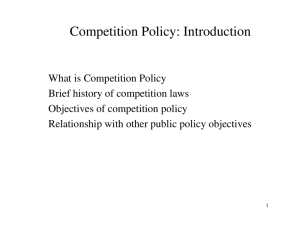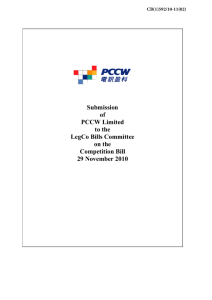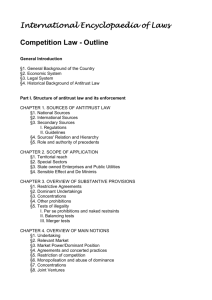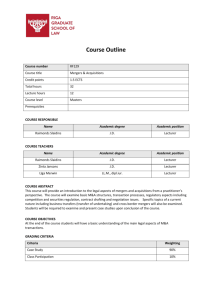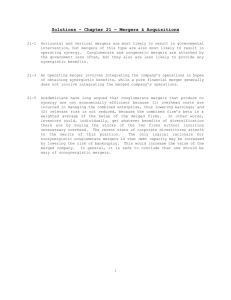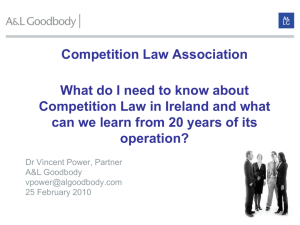Competition Policy
advertisement
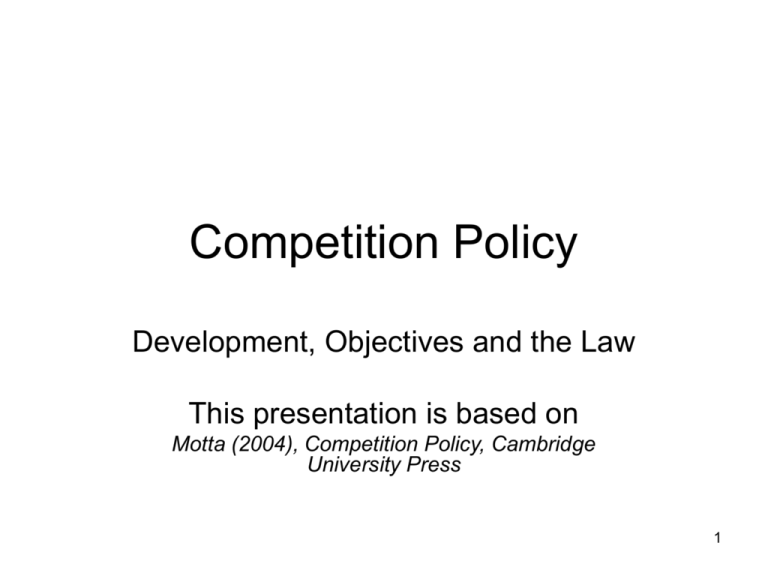
Competition Policy Development, Objectives and the Law This presentation is based on Motta (2004), Competition Policy, Cambridge University Press 1 History • Anti-trust Law in the USA – Formation of trusts in the end of the 19th century – Technology: Dramatic improvement in transportation and communication (railways, telegraph lines, telephone services) – Finance: Formation of stock and bond markets – Law: liberalization of state incorporation laws – Economies of scale and scope 2 • The organization of cartels and trusts • Final consumers were hurt by higher prices and some suppliers, such as farmers and small industrial firms • Farmers and small businesses had enough political power and public sympathy to lead to the creation of antitrust laws in many US states. 3 • Sherman Act (1890) – Section 1 prohibits contracts, combinations and conspiracies which restrain trade and prescribes impronment and fines for violators. – Section 2 prohibits monopolisation, attempts to monopolize and conspiracies to monopolize any part of trade or commerce among the several states or with foreign nations – During ist first decade of life, enforcement of the Sherman Act was not very strict. 4 • The Clayton Act – The Sherman Act did not cover mergers – The Clayton Act (1914) was introduced to extend anti-trust legislation to cover mergers capable of reducing competition – The Clayton Act prohibits other practices: • price discrimination, which lessens competition • Interlocking directorates among rivals 5 • Amendments – The Robinson-Patman Act (1936) on price discrimination – The Celler-Kefauver Act (1950) on mergers, by extending it to asset transactions – Hart-Scott-Rodino Act (1960) gave powers to the DOJ and FTC to review all mergers of firms above a certain size threshold. 6 European Union • Two different levels of jurisdiction – National – Supra-national • Many Eurupean countries have not hade proper competition laws until very recently • Treaty of Rome and its modifications • Germany & UK have distinct traditions 7 Germany • Cartels as an instrument to control the instability created by cut-throat competition and price warfare • Freedom of contracting: price agreements were legal and enforceable in the courts • Anti-cartel action was taken only in certain extreme cases (complete monopoly) • By 1905: 385 cartels, by 1923: 1500 cartels • 1923 the first Cartel law was introduced as a reaction to hyper-inflation (only registration) • National champions 8 • 1957: the first strict competition law – Bundeskartellamt • 1973: merger control 9 UK • The Profiteering Act of 1919 – To deal with excessive prices after WW1 • 1948: Monopolies and Restrictive Practices Act – Motivated by full employment • 1956: Restrictive Trade Practices Act • 1965: Monopolies and Merger Act • 1998: Competition Act – Brought the UK law almost in line with the EU law 10 Features • Objectives were never clear – „public interest“? – The Secretary of State for Industry had discretion on whether to accept or reject the OFT recommendationsPolitics! • Penalties and tools of enforcement were missing until 1998 – Later, fines (up to 10% of sales) and search power introduced 11 European Union • 1951: Treaty of Paris – Which created the European Coal and Steel Community (ECSC) – Prohibits trade barriers, discriminatory and other restrictive practices capable of distorting competition among the six countries (France, Germany, Italy, and the Benelux Countries) 12 • Reasons: – The desire of reducing the danger of German power by making available to others essential inputs such as coal and steel – Trying to mimic the US principle of free competition – Competition was not an end in itself, but was intended as a way to promote economic progress and welfare of Europeans (objective of the EC as stated by Article 2) 13 • Today, the main objectives as enforced by the EC are most probably – Efficiency – European market integration – But also „social“ goals – E.g., Ford/Volkswagen JV – Creation of 5000 jobs in Portugal! – No obvious efficiency gains 14 Objectives of Competition Policy • • • • • • • Total Surplus Consumer Surplus Defense of Smaller Firms Promoting Market Integration Economic Freedom Fighting Inflation Fairness & Equity 15 Factors Affecting Competition • • • • Social Reasons Political Reasons Environmental Reasons Strategic Reasons: Industrial and Trade Policies 16 Merger Policy in the EU • Merger Regulation (1990) • Articles 81 and 82 of the Treaty of the European Communities – Direct applicability, i.e., directly enforceable by national courts – DG Comp enforces these articles following the directives of the commissioner responsible for competition law – CFI: Court of First Instance has since 1989 jurisdiction in all actions brought against the decisions of the EC – The European Court of Justice decides on appeal actions brought against the judgements of the CFI 17 Article 81 Horizontal and Vertical Agreements (1) The following shall be prohibited as incompatible with the common market: all agreements between undertakings, decisions by associations of undertakings and concerted practices which may affect trade between Member States and which have as their object or effect the prevention, restriction or distortion of competition within the common market, and in particular those which: (a) directly or indirectly fix purchase or selling prices or any other trading conditions; (b) limit or control production, markets, technical development, or investment; (c) share markets or sources of supply; (d) apply dissimilar conditions to equivalent transactions with other trading parties, thereby placing them at a competitive disadvantage; (e) make the conclusion of contracts subject to acceptance by the other parties of supplementary obligations which, by their nature or according to commercial usage, have no connection with the subject of 18 such contracts. 2. Any agreements or decisions prohibited pursuant to this Article shall be automatically void. 3. The provisions of paragraph 1 may, however, be declared inapplicable in the case of: — any agreement or category of agreements between undertakings; — any decision or category of decisions by associations of undertakings; — any concerted practice or category of concerted practices, which contributes to improving the production or distribution of goods or to promoting technical or economic progress, while allowing consumers a fair share of the resulting benefit, and which does not: (a) impose on the undertakings concerned restrictions which are not indispensable to the attainment of these objectives; (b) afford such undertakings the possibility of eliminating competition in respect of a substantial part of the products in question. 19 Problems • H&V problematic • Concerted action leaves space for interpretations • For different reasons sectors such as agriculture, defence and transports have been granted block exemptions from Article 81 20 Article 82 (ex Article 86) Any abuse by one or more undertakings of a dominant position within the common market or in a substantial part of it shall be prohibited as incompatible with the common market insofar as it may affect trade between Member States. Such abuse may, in particular, consist in: (a) directly or indirectly imposing unfair purchase or selling prices or other unfair trading conditions; • (b) limiting production, markets or technical development to the prejudice of consumers; • (c) applying dissimilar conditions to equivalent transactions with other trading parties, thereby placing them at a competitive disadvantage; • (d) making the conclusion of contracts subject to acceptance by the other parties of supplementary obligations which, by their nature or according to commercial usage, have no connection with the subject of such contracts. 21 Mergers • DG Comp Merger Task Force • Strict deadlines 22 Issues • • • • Dominance Test Substantial Lessening of Competition Test The treatment of efficiency gains Remedies • Market Definition 23
